Burps aren't usually the most pleasant of sounds unless they're coming from your new baby. A good burp from your baby means they're releasing the trapped air in their belly, which we all know feels pretty satisfying. And, until your baby reaches a certain age, they will almost always require your assistance with burping; not because they can't burp, but because it's difficult to expel air when you spend most of your time laying down.
Air gets into baby bellies for a variety of reasons, including bottle feeding, breastfeeding moms who have an overactive letdown, or a long crying session. Still, it's a good idea to incorporate burping into your child's feeding routine. Use this article as a guide to learn all about burping your baby.
Why Do Babies Need to Burp?
The air that a baby swallows during feeding or crying becomes trapped in their tummy. This trapped air can be irritating and uncomfortable, causing your baby to fuss or cry. It can also make your baby feel full when they aren't. Burping helps in the removal of that air. Your baby will feel better once they burp and get the air out of their stomach. They may even resume feeding because removing the air will make more room in their stomach for formula or breast milk.
Babies' digestive tracts are immature, so using supportive measures like holding them upright after a feed and burping can help improve and support their digestive system. It is one method for reducing gas in infants.
While burping can be beneficial, if your baby does not appear to be in pain, you do not need to burp them every time. You shouldn't be too concerned if they don't burp.
How to Burp a Baby
When burping your baby, gently patting their back should suffice. While patting, cup your hand; this is gentler on the baby than a flat palm. When your baby spits up or has a “wet burp,” place a bib or towel on your shoulder or under your baby's chin to avoid messy cleanups.
Try different burping positions that are comfortable for both you and your baby. Many parents employ one of the following methods:
1. Cradle Method
Gently position your baby on your arm, with their chin on the opposite side of your elbow and their head facing away from you. Your arm should press against and support their stomach (place your hand between their legs). Pat your baby on the back with your free hand. Feel free to walk, sit, or rock around the room with them as you do this.
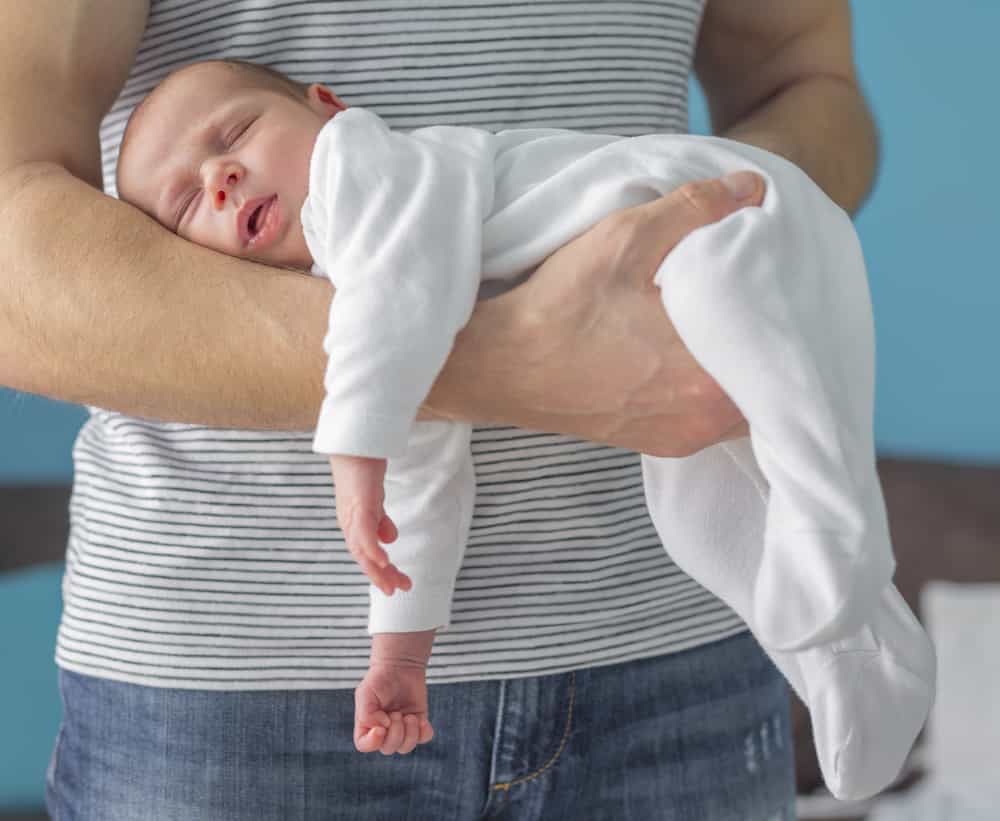
The cradle method is an excellent burping technique for sleepy babies.
©OndroM/Shutterstock.com
2. Shoulder Method
Holding your baby, prop their tummy up against your chest while sitting or standing upright. Support your baby's neck and back with one hand, making sure that their face is unobstructed by hair or clothing. Their chin should rest on your shoulder. With your free hand, gently pat your baby's back. You can try this method while slowly pacing the room, or sitting in a chair and rocking your baby.
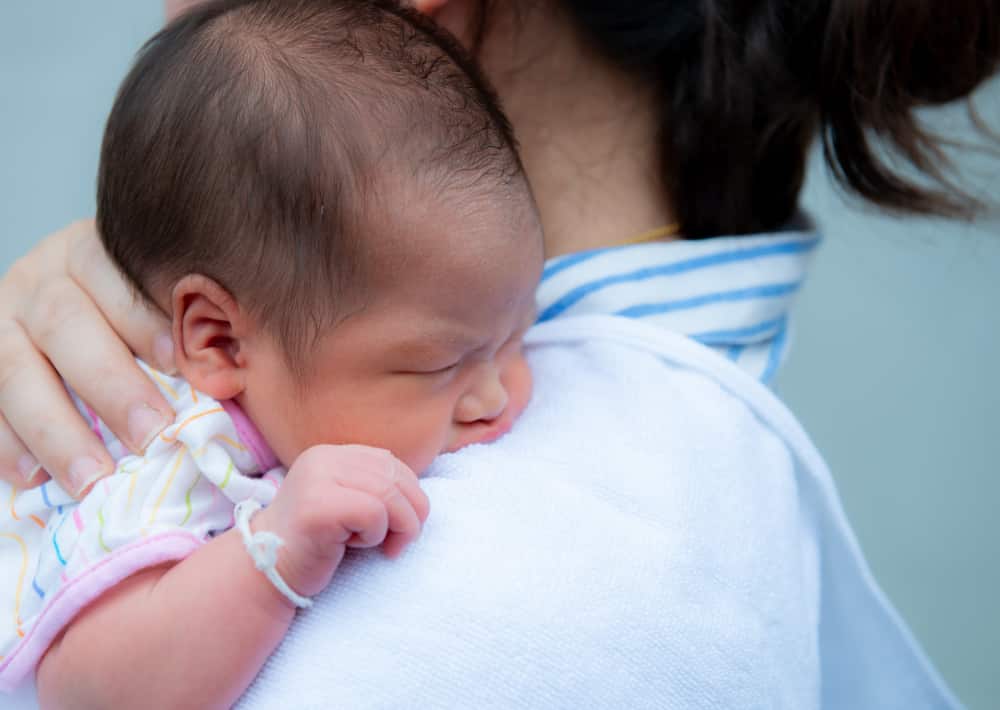
The shoulder method offers a bonding opportunity with your little one as well.
©ravipat/Shutterstock.com
3. Sitting Lap Method
Sit your baby up, in your lap, or across your knee. With one hand, support your baby's chest and head by cradling their chin in the palm of your hand. Place the heel of your hand on your baby's chest, but be sure to grip his chin, not his throat. Pat your baby on the back with the other hand.
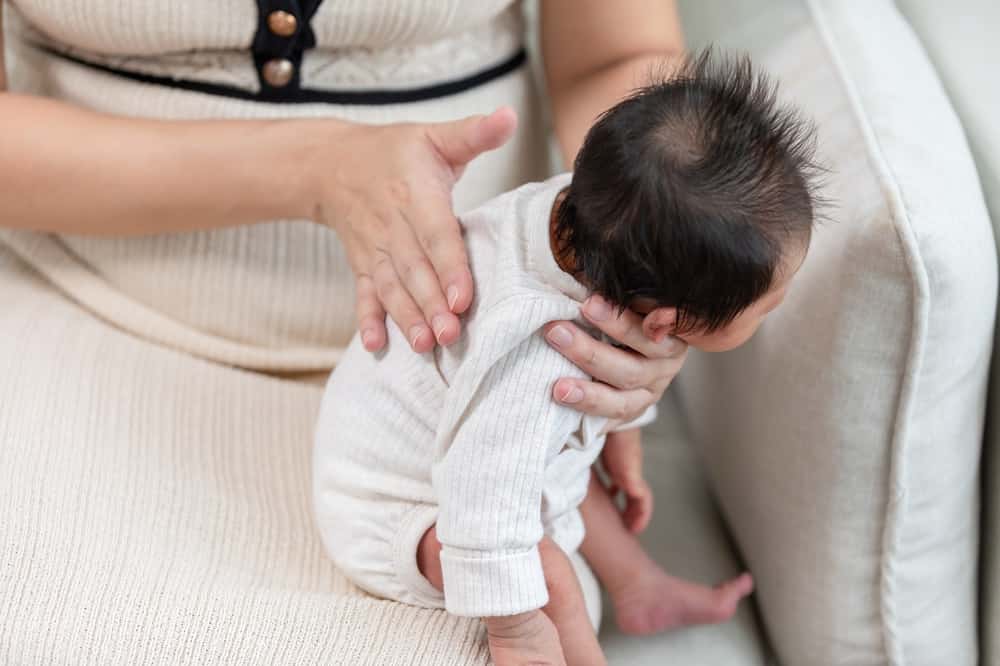
Caregivers and parents should be careful with a baby's delicate spine when using the sitting lap method.
©220 Selfmade studio/Shutterstock.com
4. Tummy-Over-Lap
Place your baby on their tummy across your lap. Make sure your baby's head is higher than their chest. Pat your baby's back gently.
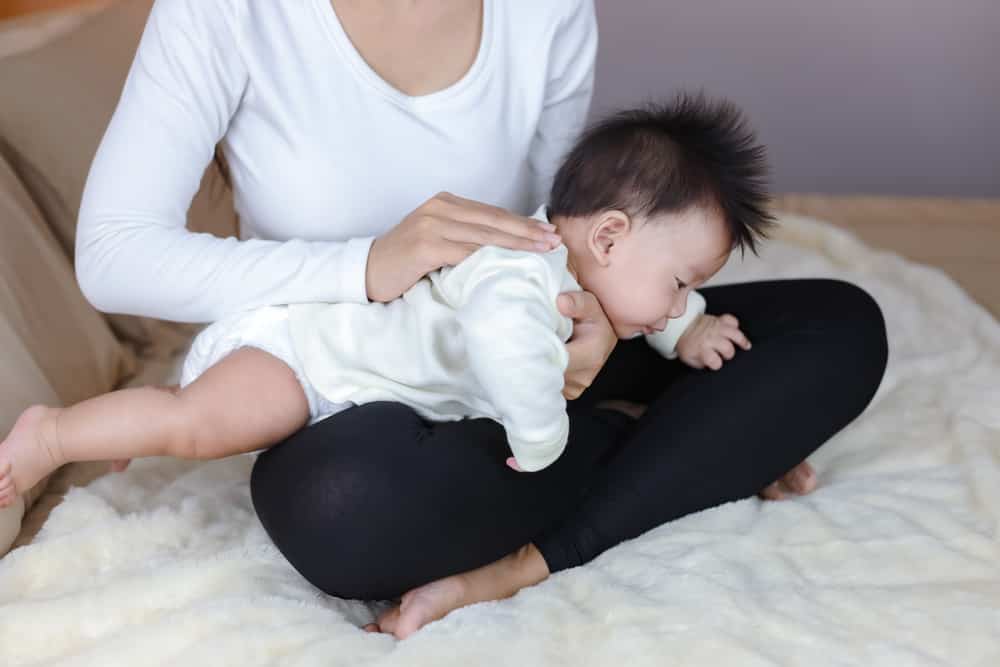
When implemented correctly, the tummy-over-lap method can also serve as your baby's tummy time.
©Yellow Cat/Shutterstock.com
If your baby appears to be fussy while feeding, stop the session, burp your baby, and then resume feeding. If you bottle-feed, try burping your baby every 2 to 3 ounces (60 to 90 milliliters) and every time you switch breasts if you breastfeed.
Burp your baby every ounce when bottle-feeding or every 5 minutes when breastfeeding if he or she
- appears fussy during feeding
- has gastroesophageal reflux (GER)
- spits frequently
- tends to be gassy
If your baby hasn't burped after a few minutes, change the baby's position and try burping for a few minutes more before feeding again. When feeding time is finished, always burp your baby.
When to Burp Your Baby
The amount of time a baby needs to burp varies from baby to baby. Burping after breastfeeds causes the baby to burp less than in bottle-fed babies because they swallow less air. Most babies outgrow the need to be burped by the age of 4-6 months.
If a baby pulls away from being fed or is squirmy, he or she needs to be burped. Having said that, the American Academy of Pediatrics advises parents to try to burp their baby:
- When a nursing mother alternates feeding between breasts or
- When being bottle-fed, every 2-3 oz (60 – 90 mL)
Frequently pausing the feeding to burp your baby slows down feeding and reduces air intake. If your baby has not burped successfully after a few minutes of trying, switch methods or give up entirely and continue feeding. It is possible that your baby does not need to burp. The best burping method for babies and parents will generally differ; use the method that works best for you.
How Long Will Your Baby Take To Burp?
Burping your child usually takes only a few minutes. Some babies burp right away – even without your assistance. Some babies will burp while feeding and will not need to be burped afterward.
It all depends on your child, how they feed, and a variety of other factors. Add to that the fact that some of the factors change from feeding to feeding, and you can see why predicting how long it will take a baby to burp is nearly impossible.
Your little one may burp right after the day's first feeding, then wait a few minutes before burping after the second feeding. However, for some parents, their baby will not burp right away – even after five minutes or more – and they may begin to feel and look uncomfortable due to the excess gas in their tummies.
Be patient and don't panic. It could take 10, 15, or even 20 minutes for your child to burp. Try some of the suggestions in this article to relieve the pressure that builds up while your child feeds and have them feeling as good as new in no time.
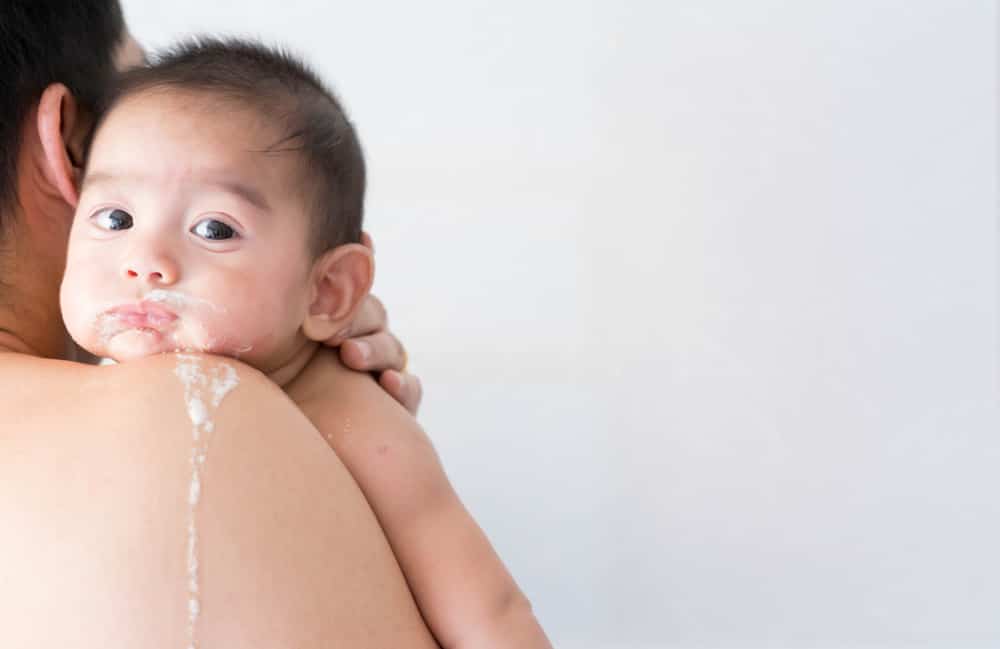
Remember to have a sizable burp cloth on your shoulder during burping to avoid messes!
©SUKJAI PHOTO/Shutterstock.com
When Is It Time to Stop Burping a Baby?
Your baby is more likely to burp on their own after about two months. Babies aged 4 – 6 months have stronger neck and stomach muscles, which prevents them from swallowing as much air. However, if your baby is gassy and fussy, keep burping and using other gas-relief methods, or consult a pediatrician.
What if Burping Your Baby Isn’t Effective?
Burping your baby for a few minutes during and after feeding is fine, but what if it doesn't appear to be helping? It can be upsetting if your baby does not appear to be bringing up the air during burping, or if they appear to be uncomfortable or crying afterward, but there are other things you can try.
If burping in one position, such as over the shoulder, does not relieve the trapped air, try another position, such as placing the baby on your lap.
If changing positions does not work, you could try the following:
Baby Bicycles
This simple exercise can aid in the manual release of gas. Place your baby on a comfortable surface on their back and gently push their legs towards their tummy in a cycling motion.
You can also gently push your baby's knees towards his or her tummy and hold the position for 10 seconds. Push, straighten, and release their legs several times, then repeat.

When burping fails to relieve gas, baby bicycles should do the trick.
©Prostock-studio/Shutterstock.com
Baby Wearing
If your baby is awake and refuses to burp, put them in a carrier, sling, or backpack and go for a brief walk. The upright position, the carrier's pressure, and your gentle movement all aid digestion and help to move gas around and eventually out.
This is also an excellent time to tidy up, do your hair, or prepare a snack for yourself – after all, you have both hands free!
Wearing your baby after they are done feeding not only helps them release a difficult burp, but it also helps you develop those bonds of love, trust, and closeness that you'll cherish as your baby grows.
Tummy Time
Tummy time can help your baby's muscles in more ways than one. A good tummy session can also apply gentle pressure to their stomachs, which can help relieve gas.
Avoid tummy time right after a feeding. Wait at least 20 to 30 minutes after your baby has been fed and the meal is settled in their tummy.
Baby Massage
Try this baby massage technique the next time your baby wriggles uncomfortably after feeding or pulls at his or her legs (both of which are likely signs of gas):
Place your baby on his or her back so that you can face each other. Apply a small amount of massage oil to your baby's skin, beginning with strokes from the top of the chest and working your way down to the legs and feet. Cross from the right to the left side of your baby's shoulders, curving around the belly button and stopping just above the diaper line.
In slow, gentle clockwise motions, circle your baby's belly button. This aids in the movement of gas through the digestive tract. To encourage gas relief, draw parentheses on either side of your baby's belly button with both hands.
Massaging your baby can help relieve tummy troubles, and it doesn't have to be time-consuming. Anywhere from 5 to 20 minutes per day can help to relieve gas pains. This method can also help improve your baby's sleep at night, which is why it is ideal to incorporate baby massage into a nighttime routine before bed. For added relaxation, you could sing a song to your baby or play soothing music while performing the massage!
Be Patient
When you rub or pat a baby, he or she may not burp right away. Be aware that the process may take some time. Wait a few minutes before attempting again. Staying patient also shows the baby that you are calm and in control, rather than rushed or anxious.
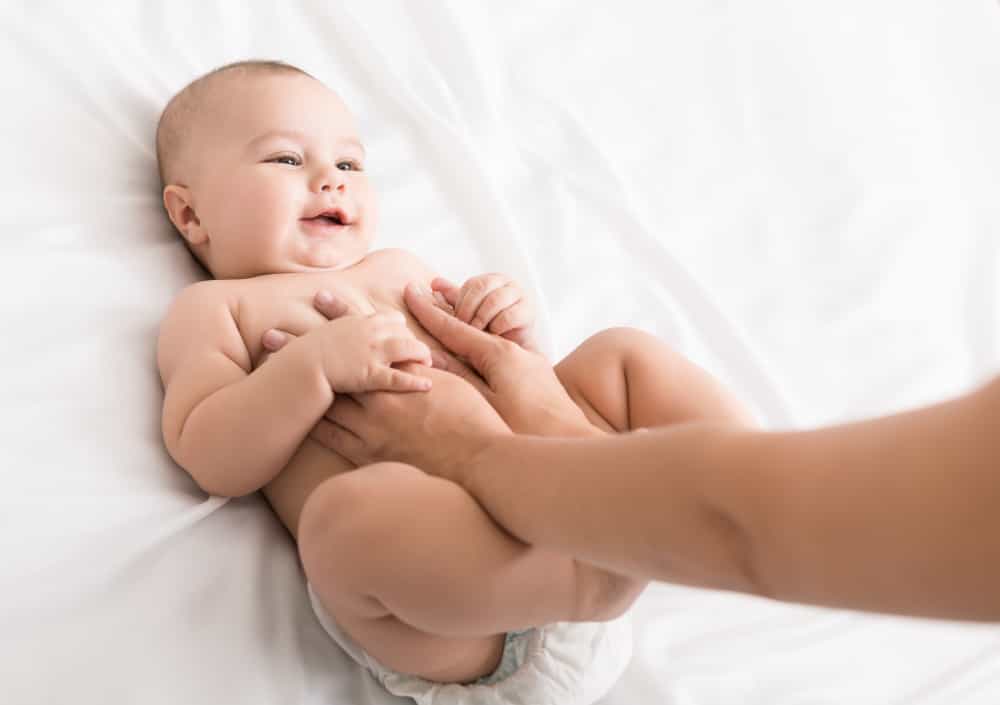
Baby massages have multiple benefits and are worth including in a baby's daily routine.
©Prostock-studio/Shutterstock.com
Burping and Spit Up
Whatever position you choose to burp your baby in, keep a burp cloth nearby, such as a receiving blanket or cloth diaper, in case your baby spits up when they burp. Parents and caregivers are frequently concerned when their babies spit up what appears to be a large amount of milk. Spitting up is normal most of the time, and infants only spit up a teaspoon or two of milk, though it may appear to be much more.
Parents and caregivers should rest easy knowing that the likelihood of choking on spit-up is extremely unlikely. However, it is still critical not to overfeed your baby and to try to burp them after each feeding if they appear to benefit from it.
If parents are still concerned, they should consult their doctors, especially if the spit-up is colored, bloody, projectile, appears excessive, or the baby is not gaining weight. Some babies do have gastroesophageal reflux, also known as acid reflux, a condition in which stomach acid backs up into the throat. The doctor may prescribe medication to make them more comfortable, but caregivers can also help by adjusting their feeding technique.
They can feed the baby while standing up, keep them upright for at least 30 minutes after the feeding, and burp every few ounces. Babies with this condition typically outgrow it by the time they begin eating solid foods.
Conclusion
It's normal if your baby cries or spits up after or during feedings. Burping can help with this, which is very common and expected. If one burping technique fails, you can usually find success by trying another. While spit-up may dribble out of their mouth, it most likely indicates that excess air has been released and your baby's tummy is feeling better.
Keep in mind that not all babies burp frequently. Some babies pass so much gas that they don't need to burp as often.
If your baby is not bothered by gas pains, does not burp frequently, and is on track for growth and weight gain, then there is no need to be concerned about burping.
If, on the other hand, your infant appears to be uncomfortable after feedings but isn't burping much, there could be a problem that needs to be addressed by their pediatrician as early as possible.
The image featured at the top of this post is ©PRPicturesProduction/Shutterstock.com
